A high-stakes legal fight is brewing in Tampa, Florida, between Swiss suppressor innovator B&T and U.S. industry giant SureFire. At the center of the dispute is a quick-attach suppressor system, and both companies claim they invented it first.
On May 30, 2025, B&T USA and its Swiss parent company, B&T AG, filed a federal lawsuit [embedded below] challenging U.S. Patent No. 7,676,976, which covers SureFire’s popular quick-detach suppressor mount. B&T alleges it developed and publicly displayed its system as early as 2001 and even sold units to the U.S. military and Navy SEAL teams in late 2002—years before SureFire filed its patent in 2005.
According to B&T, that makes their design prior art, potentially invalidating SureFire’s claims.
Not just a fight over intellectual property. B&T argues that the two companies had a verbal “handshake” agreement dating back two decades: B&T wouldn’t challenge SureFire’s patent as long as SureFire didn’t enforce it against them or their customers. That peace ended abruptly when SureFire reportedly sent cease-and-desist letters to B&T’s partners, including Sons of Liberty Gun Works, threatening legal action if they continued using B&T’s adapter system. SOLGW ultimately pulled the product from their lineup.
Now B&T is asking the court to declare SureFire’s patent invalid, affirm its right to sell its Rotex suppressor mounts, and award damages for breach of contract and tortious interference. The case has the potential to shake up the U.S. suppressor market for years to come.
B&T’s Claim: “You Knew We Did It First”
In the excellent interview by GunTuber James Reeves, playing at the top of the page, we get the details from B&T’s Swiss headquarters.
CEO Karl Brügger explained why his company filed suit. “We developed a locking system for a suppressor in 2001… the design was not even original to us; it was from a pipe connection from another industry, which we adapted to a suppressor.”
Brügger claimed that in 2002, B&T showcased the system at a trade fair in Germany. “A SureFire employee at that time took pictures of that lock. We didn’t care because we thought it wasn’t an issue,” he said.
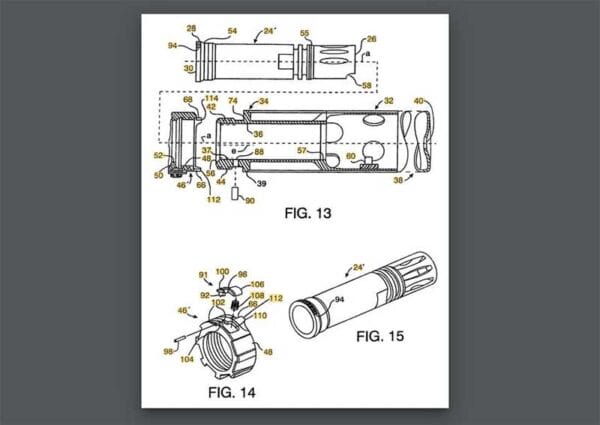
By 2004, Brügger learned that SureFire had filed a patent. “We said, ‘Oh [expletive], that’s what we designed.’ I contacted SureFire and asked for a letter granting us free use of the design. After some disputes, we had a verbal agreement and handshake—they would never sue us.”
Brügger insists his company isn’t looking for a fight but was forced into court.
“We don’t want to get threatened with letters from lawyers, and our customers cannot buy our mount because they’re scared of getting sued. We tried to resolve this outside of court, but there was no other way.”
SureFire Fires Back
SureFire countered with its own statement, insisting that it made “multiple good-faith attempts to settle the matter directly with B&T” but received little cooperation. “Several individuals within SureFire attempted to discuss these issues with Karl and B&T USA, and these attempts went almost completely unanswered,” the company said.
SureFire also disputes the scope of the alleged handshake deal. “The informal agreement with B&T… was specifically regarding suppressor lock ring design. Permission was given to B&T to manufacture suppressors of this sort. However, permission was never given for B&T to manufacture SureFire’s mounting interface or muzzle devices to mount SureFire SOCOM Fast Attach® suppressors.”
The company added, “The appropriate forum for resolving such matters is the court system.”
What’s in the Court Docs
The lawsuit filed by B&T on May 30, 2025, in the U.S. District Court for the Middle District of Florida alleges that SureFire withheld crucial evidence from the U.S. Patent and Trademark Office during the application process for its suppressor mounting system patent (No. 7,676,976).
Specifically, B&T claims it exported its Rotex-II suppressors—featuring the now-contested quick-attach system—to the U.S. in August 2002, more than two years before SureFire filed its patent application in June 2005. Those suppressors, according to B&T, were delivered to the U.S. Naval Warfare Center and were supported by export licenses, shipping records, and engineering drawings—all of which were shared with SureFire at the time.
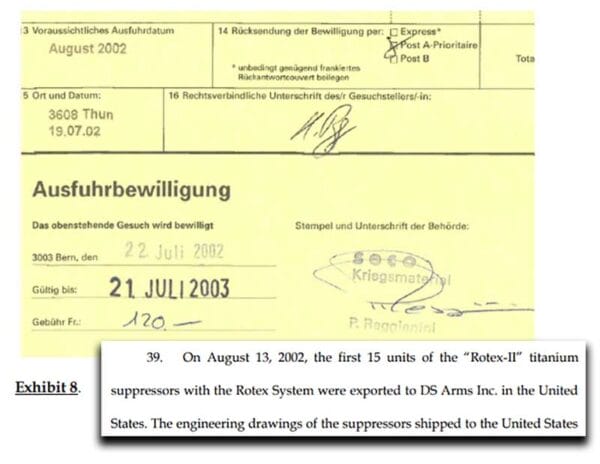
B&T further alleges that SureFire later submitted an “Information Disclosure Statement” to the USPTO in 2006, referencing a 2002 B&T drawing and noting that Rotex suppressors had been marketed in Europe. However, SureFire allegedly failed to mention the more damaging fact: that they had been sold and delivered in the United States—an omission B&T calls “intentionally misleading.” According to the complaint, had the USPTO been informed of the U.S. sales, the patent would have been rejected under 35 U.S.C. § 102, which bars patents on inventions already sold in the U.S. more than one year before filing.
The complaint also details SureFire’s legal threats against B&T and its customers, including a cease-and-desist letter sent to Sons of Liberty Gun Works in January 2025. That letter allegedly forced SOLGW to cancel unfulfilled orders and remove B&T-manufactured muzzle devices from their catalog. B&T characterizes this as not only a breach of their long-standing verbal agreement with SureFire, but also as tortious interference with business relationships.
In addition to seeking a declaratory judgment that SureFire’s patent is invalid and unenforceable, B&T is asking the court to award damages for breach of contract and interference. The suit further argues that SureFire’s patent suffers from “obviousness-type double patenting,” claiming it is not meaningfully different from SureFire’s earlier patent (No. 6,948,415), which expired in 2023.
Live Inventory Price Checker

|
Socom556-Rc2 5.56 Quick Detach Suppressor - Socom556-Rc2 5.56mm Qd Mount Suppressor | Brownells.com | $ 1169.00 |
|
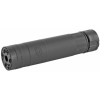
|
Rugged Razor 762 Rifle Suppressor, .30 Cal Quick Detach Suppressor, Black | Bereli | $ 699.00 |
|

|
Socom556-Rc2 5.56 Quick Detach Suppressor - Socom556-Rc2 Fast-Attach Sound Suppressor Dark Earth | Brownells.com | $ 1169.00 |
|

|
Lunar 9 Qd 9mm Luger Handgun Suppressor - Lunar 9 Qd 9mm Luger Quick Detach Suppressor Black | Brownells.com | $ 679.00 |
|
Why This Case Matters
What we are witnessing here is not just a technical dispute over suppressor mounts—it’s a clash between two powerhouse brands whose products are trusted by elite military units, law enforcement, and civilian shooters worldwide. The outcome has the potential to shift buyer loyalty and even influence future defense contracts. If B&T succeeds, it could knock down one of SureFire’s key intellectual property claims and open the door for more competitors in a market that has long been dominated by a few major players.
At the heart of this legal fight is a bigger question: Can a decades-old handshake agreement still hold weight in today’s highly litigated firearms industry?
If the court finds that SureFire’s patent was granted improperly or wielded unfairly to push out rivals, it could set a precedent for how intellectual property disputes are handled—not just in the suppressor world, but across the entire firearms accessory market. Smaller manufacturers watching from the sidelines may either breathe a sigh of relief or tighten their own legal agreements depending on which way this case goes.
The stakes for the market are huge. A win for B&T could throw open the U.S. market for its quick-attach Rotex mounts and spark a wave of innovation as SureFire’s patent nears its June 2026 expiration. Other companies could quickly move in with their own versions of quick-detach systems, giving consumers more choices but also risking a flurry of new legal battles. On the other hand, if SureFire prevails, it will reinforce the power of established patents and likely discourage aftermarket firms from trying to design around them.
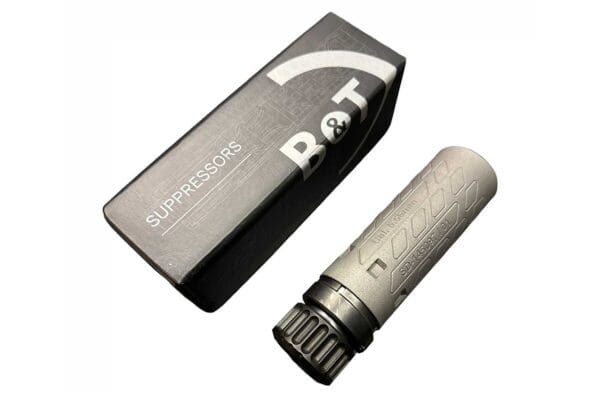
What’s Next
The court will decide whether B&T’s claims hold up. If the patent is invalidated, other suppressor makers could quickly pivot and bring new designs to market. Until then, the suppressor community is watching closely.
What’s your take—Did B&T get robbed, or is SureFire just protecting what’s theirs? Let us know in the comments below.
B&T USA v. SureFire, LLC – Declaratory Judgment Complaint


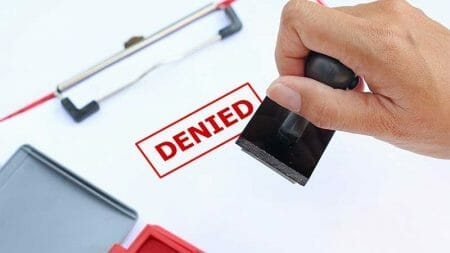


pipe company should sue shurefire a pipe is a pipe
Why would B&T send SureFire “export licenses, shipping records, and engineering drawings” on B&T’s suppressors sent to the U.S. military 3 years before SureFire filed for their patent?
Then there’s “By 2004, Brügger learned that SureFire had filed a patent” which is later refuted by “Specifically, B&T claims it exported its Rotex-II suppressors—featuring the now-contested quick-attach system—to the U.S. in August 2002, more than two years before SureFire filed its patent application in June 2005” (emphasis added).
The timeline doesn’t track. Whether that’s actual to the case or just poor writing on the part of the author, I couldn’t say.
It does seem illogical not to patent a design right away. On the other hand, if what B&T says is true, it makes Surefire look sleazy and unmannerly! I know not many people care about manners or ethics anymore, but I sure do!
I’m not an attorney, but I DO have my name on a number of patents as either sole- or co-inventor. If it can be proven in court that prior art exists which publicly disclosed design details claimed in a later patent, those claims – and maybe the entire patent – will be ruled invalid. Sometimes companies disclose prior art in small – but public – venues JUST to prevent someone else from patenting what they’re doing. I don’t know exactly what happened here, but if what B&T says is true about their prior art, I expect they’ll prevail.
I find it hard to believe that B&T after millions of dollars in RND didn’t file a patent before showing it off to the world.
There’s more going on here.
But it doesn’t matter to me. Because Trump and the Republicants PROVED they’re not 2A supporters and didn’t remove suppressors from the NFA, I won’t be buying any.